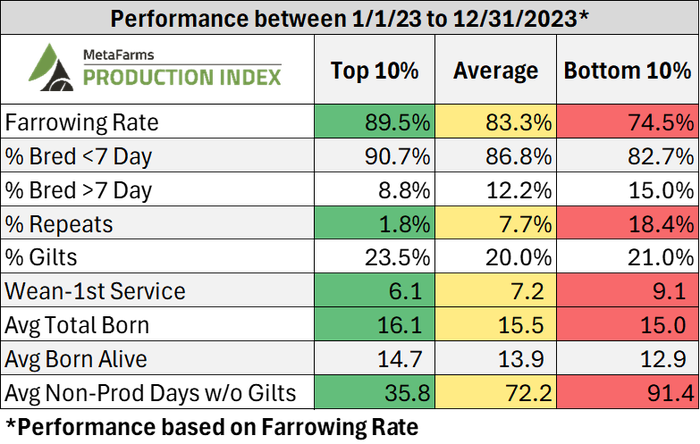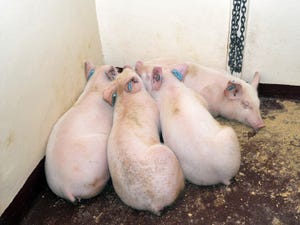Maximizing pork production: Importance of a quality breed target
Sow farms that have the best opportunity for consistent farrowing rates, productivity, will drastically minimize any repeat services in their farms.
April 16, 2024

By Bradley Eckberg, MetaFarms
At the heart of every pork production operation lies the goal of economic efficiency. Maximizing profits while minimizing costs is the ultimate objective. Different swine genetics possess unique characteristics that can significantly impact production economics. Factors such as growth rates, feed conversion ratios, and meat quality attributes play pivotal roles in determining profitability. One of the most important measures of sow farm production is achieving the target set for weekly or breed batch targets which, if not met, can have long term implications through the grow finish system, and into marketing obligations. This article will cover the importance of having a quality breed group makeup and the challenges that go along with it.
Sow farm analysis was performed utilizing the MetaFarms Ag Platform with specific focus on the United States customers only. In the calendar year 2023, the number of sow farms was slightly more than 350, with an average female inventory of 800,000. The average sow farm size was 2,666, with the smallest farm size of 500 females and the largest at 11,000 females.
Setting a breed target
Pork production is a multifaceted industry, influenced by various factors such as genetics, health, labor, market demand and economic considerations. One of the main focus areas in sow farm production is setting a breed target for a weekly or a batch farm. The first thing a sow farm will look at is the capacity of the farm from the number of farrowing crates to the number of gestation crates and/or pens. For example, an average breed target for a 2,400 head sow farm can be 135 weekly services, whereas a 5,500 head sow farm could have a target of 465 weekly services.
Another variable to consider is the impact that warmer weather has on farrowing rates. Most sow farms will consider and adjust the normal breed target by adding an additional 5-10% more per week or batch. In May 2023, the MetaFarms Ag Platform’s average farrowing rate was 85.4%, whereas in August 2023, the average farrowing rate was 83.2% (2.2% decrease).
Let us use a 2,400 head farm that has a breed target of 135. This farm usually has a farrowing rate of 90% but during August, the breed target was not adjusted, and the farrowing rate went down to 85%. With a 90% adjusted farrowing rate, the farm was farrowing 121 sows and weaning 1,391 pigs per week (11.50 pigs weaned per sow farrowed). But now, because the breed target was not adjusted for summer months, the farms 85% farrowing rate generated 114 sows and pigs weaned of 1,311 per week. To put an economic value on the wean pig difference, 80 less wean pigs per week times $35 per pig equals $2,800 less income for the farm.
The chart below shows sow farm production percentile breakdown based on farrowing rate for the calendar year 2023. The top 10% of sow farms’ farrowing rate average was 89.5% which was 15% higher than the bottom 10%. When analyzing the core differences in breed group makeup, the top 10% farms bred more wean sows before day 7 and far less repeat services. The direction outcome saw a 1.1 advantage in total born for the top farms.

Breeding returns: Don’t do it
A mistake that many farms make is breeding repeat or return animals. A return animal would be referred to as a pig that returns to estrus (heat) after an unsuccessful mating or insemination attempt. Returns can be that of a sow or gilt that comes naturally into estrus as well as a pregnancy check negative, an abort, and not in pig.
Below is a chart that looks at 100 sow farms that had rebreed service performance by the number of return services as well as parity differences. Data was evaluated for the first 11 months of the calendar year 2023 to finalize the farrowing outcomes for this publication. Data shows that across the service numbers, farrowing rates and average total born decrease at an alarming rate. In the MetaFarms Ag Platform, in 2023, the average farrowing rate for all services was 83.6%, which is over 15% higher than the best average for repeat services. Average total born in MetaFarms for 2023 was 15.3 pigs, 0.3 pigs better than the repeats below. The sow farms that have the best opportunity for consistent farrowing rates and farrowing productivity, will drastically minimize any repeat services in their farms.

In my past, I worked on four different sow farms over a nine-year period, with my main area of production focus being that within the breeding and gestation barns. Every single day, one of the main focuses of our job was finding new animals to service. There were some known and unknown expectations of new daily service totals from a day-to-day basis.
Known and unknown:
Wean Sows:
Definition: Wean sows that had recently undergone the process of weaning her piglets.
Known: Eighty percent or more of wean sows will come into heat by day 7 post wean.
Unknown: Number of the total available within the wean sow pool and then subsequent number of actual services.
Open Pool:
Definition: A group of sows that are not currently pregnant or lactating.
Known: Every 21 days a female sow or gilt will come into estrus.
Unknown: When and how many. When a wean sow is not breed within the first week post weaning, there can be some underline reasons why, which can be challenging for estimating when she will come into estrus again. There are tools available to heat initiate estrus which can be very helpful with filling those days of lower new services.
Gilt Pool:
Definition: Reservoir of potential replacement breeding females for the sow herd.
Known: If heat no services are collected, then a farm can proper time and manage gilt pool services.
Unknown: Total available within the pool. Poor farm management planning on replenishing gilts can lead to a lower pool of available gilts to breed. Not tracking heat no services on gilts will also leave a very big unknown of when she will come into estrus again.
In the complex landscape of pork production, setting breed targets is a strategic decision with far-reaching implications. By carefully selecting breeds that align with economic goals, market demand and genetic potential, producers can optimize efficiency and mitigate risks. As the industry evolves, breed selection will remain a cornerstone of successful pork production operations, driving profitability and sustainability in the long run.
MetaFarms Analytic Insights were used to provide the context and trends for this article. If you would like to talk or see an analysis of breed group makeup with trends for your farm, or if you have suggestions on production areas to write articles about, please e-mail or call us. We enjoy being a part of the National Hog Farmer Weekly Preview team. Previous Production Preview columns can be found on the National Hog Farmer website.
If you have questions or comments about these columns, or if you have a specific performance measurement that you would like us to write about, please contact Eckberg at [email protected].
You May Also Like



